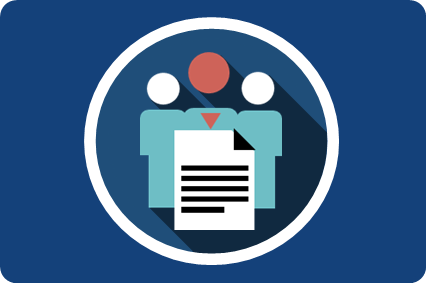The Who’s Who of Writing a Great New Lease Agreement
Updated 18th June 2021 | 6 min read Published 22nd January 2015

Arranging the details of a new lease agreement is a vital part in the lifecycle of a lease and needs to be done correctly. The agreed lease schedule will be referred to throughout the lease period so it is important that the right people are involved in making the correct decisions when negotiating with the lessor.
Here’s some of the people that you should think of when planning a new lease schedule.
End-Users And Operations Managers
Whether it’s Toby using the copier, Janet managing the data server or Dean working the fork lift truck, it is the operational user who is going to get the first hand benefits of the asset. They are the ones who use the leased assets on a day to day basis and know what it is that they need from the equipment. It is important to find out what is realistically required from an asset so the lease schedule can be negotiated accordingly to make the lease schedule’s terms as optimal and attainable to the needs of the company as possible.
It is also important that the end-users are aware of any obligations in maintaining the assets. Common sense should of course stop anyone from purposefully damaging assets, but is everyone aware of what they can and cannot do with a leased asset? Some leasing contracts include return conditions such as limitations on vehicle mileage/usage hours – it is easy for a procurement team to say this will not be exceeded, but if the drivers are not aware of these restrictions then this could lead to costly charges when it comes to returning the asset at the end of the lease period.
Procurement
The procurement team will generally deal with most of the processes involved in formulating and carrying out the lease agreement. They will source the equipment based on the operational needs and financial restraints of the company, finding the best deal, purchase and lease prices as well as other features of the lease. It is vital that they are updated on any requirements, processes or problems with an active lease. If an issue does occur, such as damage to a leased asset or a call about renewal of an existing lease agreement, the procurement team should be contacted in plenty of time to help resolve the requests.
It can be tempting to allow damages and maintenance to go unchecked or important decisions regarding the end of lease to be made by the operational users as they are the ones who deal with the leased assets most often. However, the people in procurement are the ones who have organised the lease schedule, know the requirements and obligations of both the lessee and the lessor as well as the options and best practice for arranging factors such as early termination, maintenance checks or a lease contract renewal.
Finance
The financial element of a lease comes in two forms – the pre-determined payment instalments and the accounting aspects of reporting liabilities on the balance sheet. Firstly, it is important to make sure that payments can and will be met consistently during the lease. As leasing is a long term solution that reduces initial capital expenditure across the lease life, payments can be cheaper than buying outright. However, it will also require some thinking ahead to ensure that when payments come around, you’re able to make them – normally these payments would need to be approved anyway. Negotiating a competitive lease rate and bartering the initial purchase price can all help leasing become an even more cost effective solution for asset procurement.
With lease accounting standards seeing a dramatic change, operating leases will soon no longer be excluded from the balance sheet. This may have a knock on effect to the financial status and reputation of the company. When agreeing new leases, it is important that the impact on the accounting reports have been considered and the investment is considered and negotiated accordingly. Your company needs to be clued up on the new lease accounting standards and its effects – according to recent research by Grant Thornton, many companies are not in this position!
Legal
At the end of the day, lease schedules, master leases or any other type of lease documentation are forms of contracts. They need approval and checking before they are signed as they list the obligations your company will need to adhere to as a lessee. With your expert legal team on hand you can minimise the risk of nasty surprises hidden in the small print.
Leasing Experts
Whether you have them in-house or outsource to experienced professional consultants, the involvement of a leasing specialist in the process of arranging a new lease can be the difference between a good, a bad and even a fantastic deal. Leasing experts know that a competitive rate is only one aspect of a great lease – return conditions, assets usage allowance, fair wear and tear and other clauses are just as important to make sure the lease ends as seamlessly as it is agreed. Innervision’s clients rely on our leasing specialists’ expertise to help secure the best deals for their asset requirements as well as aiding in making the end of lease process as stress free as possible. Leasing experts are a vital addition to your leasing process so you can be confident that the agreement you are signing is going to be worth it.
The Lessor
A lease agreement is made up of two sides and although they are not sworn rivals, the lessee and lessor stand at separate ends of the leasing process. The lessor is the one that initially funds the new asset and therefore legally own the equipment. They will have their own priorities and processes to follow so it is important to agree a position that suits both parties in the lease. There are several types of lessors (as seen here), each with their own advantages and disadvantages, but generally it is important to keep them in the loop and negotiate realistically so as to maintain a strong relationship throughout your lease and any other future ones you may agree with them.
Although the majority of lessors are more than agreeable, there are some that should be avoided so be wary of contractual terms, harsh return conditions or hidden additional charges. However, keeping an open channel of communication and a mutual respect for each other’s role in the lease agreement can help ensure your leasing relationship with your lessor is plain sailing.
Want to know more: What to Look for When Deciding on the Right Lessor
The message is clear, leasing should involve more than one person to ensure the deals negotiated are best suited for all of the company’s requirements. Communication is key in the leasing process and one of the best ways to ensure that everyone who needs to be involved can have their input is the implementation of lease management software. Uploading all your active leases and arranging any new ones through intuitive lease portfolio management software allows you to fully track the leasing process, ensure you have the correct and relevant data on file and always accessible as well as run reports on your leases to make sure you are getting the best out of your deals.
For more information on leasing management software, download our guide:
Share This Blog




